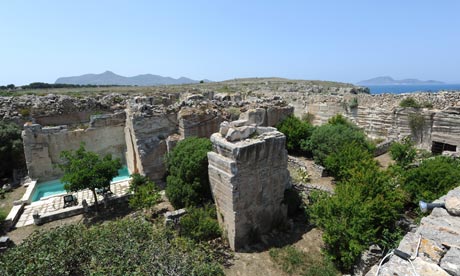
Beds in concrete sewer pipes, converted prisons and factories, hotels made from ice or old railway carriages ... over the last decade or so the travel industry has thrown up more and more bizarre ways for us to be accommodated.
These wacky places to stay may be entertaining, but usually they're the accommodation equivalent of fancy dress – funny for five minutes, then you wish you were in something more comfortable. A villa in a quarry sounds like another example of quirk over quality – not really somewhere you'd want to hole up for long.
On the tiny, sleepy Egadi island of Favignana though, staying in a quarry is a stylish prospect. Since Roman times, tufa, a pale limestone was excavated here for buildings across Sicily, and islanders have incorporated the remaining holes and blocks into developments. Now a gorgeous rambling seaside villa, Zu Nillu, built into a disused Roman tufa quarry that has been turned into a spectacular garden, is newly available as a holiday let, exclusively through specialist operator Think Sicily.
Rather than JCBs and rusting shopping trollies, this verdant Escher print of a quarry features small square lawns, shady quadrants full of orange and pomegranate trees, cacti and palms, with raised platforms and sun-terraces interconnected by stone walkways and zigzagging staircases, some several metres above the ground (not a place for young children). Two main buildings sleep eight, and descend from ground level into the sunny garden, but several freestanding monoliths are being turned into extra rooms, and hidden away in secret corners are an open-air bathroom under a cacao tree, and a fabulous pool set into the quarry walls.
It is owned by an Italian actor and film director, Ricky Tognazzi, who has decorated it with unusual antiques (sculptured day beds, Moorish tiling, decorative masonry). His name meant nothing to me, but it became apparent during my stay that Tognazzi is famous – perhaps the Italian equivalent of Mike Leigh … or at least Michael Winner. When I sunbathed on the flat roof of the main house I would hear the excited peal of Italian tourists below, posing for photos outside our celebrity's front door. They could never see my boyfriend or I in our secluded confines behind the high walls or below ground level, but I could excite them further by shouting inside to "Ricky" in my best Eeee-talian scorchio! accent.
Ricky Tognazzi seems to have a rather nice life here, and it was lovely to borrow it for a while. Like a heated up version of the Scilly Isles, the Egadis are incredibly peaceful and undeveloped. Pedalling off on hire bikes with snorkels, books and rolled-up towels in our baskets each morning, we cycled quiet dusty roads around the butterfly-shaped island, which lies four miles off the west coast of Sicily, a short ferry ride from Trapani – plenty of visitors just go for the day. Favignana is only seven square miles (its neighbours, Levanzo and Marettimo, are even smaller and more sleepy than this soporific little place) and flattish but for a few small mountains, and it resembles a half-completed game of Tetris in parts, with oblong pillars and square holes left by the excavations.
Seafront quarries have left fantastic platforms to dive from at Bue Marino, Cala Azzurra, and our own Cala Rossa, the island's (some say the Mediterranean's) most beautiful cove, where Zu Nillu is the only building. On calm days people would flock there – I counted 37 yachts in the bay one day – but the Italian sun-worshippers seemed to follow a secret law that certain weathers called for certain spots, and a breeze made them abandon Cala Rossa for a more sheltered spot.
We took advantage of the culture of conformity, but could always find peace anyway in our private, sea-facing walled garden across the road from the house, where we took lunches of smoky ricotta with peaches and honey, papery salami and Sicilian white wine. We had expected a lot of the food on this old Sicilian fishing island. Tuna and sardines were once hugely important, though much is exported now and tuna has become something of an artisan product – tins of it cost €20 and more in the gift shops. Bottarga, dried tuna roe, featured in many of the islands' delicious pasta dishes (the villa provided a guide to restaurants, such as the highly recommended El Pescadore, and a concierge on call to make bookings) but we were disappointed to see many restaurants used frozen fish in some dishes (marked on the menu), and found most a bit overpriced, charging €15-€20 for a grilled tuna steak. Our favourite find was the cheap arancini shop Girarrosto Rosticceria, where fried rice balls filled with aubergine, cheese or sausage cost a couple of euros. Another brilliant bargain was at the almost Ibiza-esque bars of Monique and Camarillo Brillo in Favignana town, which had free aperitivo buffets in the evening. The stylish Hotel delle Cave (hoteldellecave.it, doubles from €80 B&B) also has a garden in a quarry, and is lovely for drinks and perhaps to stay. But we couldn't resist the lure of a rooftop sundowner in our labyrinthine home – which did almost feel like our home by the end, Ricky's no longer.
• A week at Zu Nillu costs from £2,530 for two or from £5,040 for eight, including cleaning and welcome pack, with Think Sicily (020-3131 2912, thinksicily.com). EasyJet (easyjet.co.uk) flies to Palermo from Gatwick

